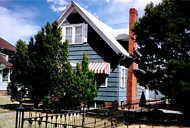
Now that I'm back in Vancouver, that isn't so important. On the other hand, Curt and Judy are both in California....
A secondary objective is to provide interesting and useful information for the Internet at large. I'm thinking that most people in this category would be casual readers who find their way here at random, through a search engine.
They should be visually interesting, which means using photos.
They shouldn't be painful to download.
They shouldn't take a long time to set up and maintain. I'll have a limited amount of time to spend on this, probably a few hours a week.
Pages should not move around. In particular, if someone bookmarks an HTML page, it should not break.
You can set up a web page on GeoCities for free, with up to 11 Mbytes of disk space (enough for the complete text of 11 average-sized novels!). You need to include an ad banner on each page, or GeoCities will pop up an ad banner whenever someone looks at one of your pages.
I'm paying US $5/month for GeoPlus service. What I get: no advertising requirements, more disk space (25 Mbytes), and a shorter URL (http://geocities.datacellar.net/~rwvong/).
Disk space used to be a problem -- you can fill up 2 Mbytes surprisingly fast if you're putting images on your web pages -- but not any more.
Use pictures on each page for visual interest, either scanned from 4x6 photos or captured from Video CDs. To keep the pictures from causing the download to grind to a crawl, put a small version of each image on the page, and link it to the full-size version. See Philip Greenspun's web site for examples.
Where possible, use 768x512 for scanned photos, 192x128 for the small versions. Use 24-bit color.
Use the HEIGHT and WIDTH tags to allow the web browser to lay out each page before the images are loaded.
Don't try to compete with professional graphic designers using Adobe PhotoShop and font designers.
Use a consistent layout for each page, with the following elements:
If the number of pages grows very large, then second-level index pages may be necessary.
Scanning in pictures takes a couple hours, plus another couple hours for editing them and adding text.
For a page which is primarily text, it probably takes two or three hours to do formatting, editing, and revisions, plus whatever time it takes to write the text in the first place.
For a really basic introduction to creating web pages, see Eric Meyer's Introduction to HTML.
For greater readability, I've changed my e-mail address to russilwvong@yahoo.com, and I've also set up an e-mail address for Abby, abigailfitch@yahoo.com. The rwvong@geocities.com address still works, of course. All three addresses are forwarded to our local ISP mailbox.
The URL that I give out now is www.geocities.com/rwvong (with no tilde -- it's easier than explaining what a tilde is), although www.geocities.com/~rwvong and www.geocities.com/Athens/Forum/2496 will also work.
Since GeoCities doesn't provide any password protection facilities, I used client-side JavaScript. From the irt.org FAQ database: to protect a web page, give it a filename which is not easy to guess, then use the filename as the password. The article includes a simple client-side Java script which prompts the user for the password, then tries to access the corresponding file. An incorrect password results in a 404 File Not Found error.
I used the WinGuides.com Password Generator to generate random filenames, and put the protected web pages into a subdirectory named password.
Since we want friends and family to be able to look at multiple protected web pages with a single password, I set up a top-level web page with its own password. From the top-level page, you can access all of the protected pages without entering additional passwords.
To provide access to the top-level page, the index.html file in the password directory prompts the user for the top-level password, using the supplied client-side Java script. Each directory which we don't want users to access directly also contains a copy of this index.html file.
We can change the top-level password by simply renaming the top-level file and distributing the new password to friends and family.